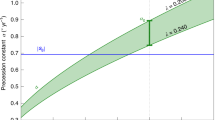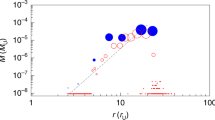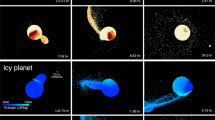Abstract
Recent studies1,2 have revealed that all large (over 1,000 km in diameter) trans-Neptunian objects (TNOs) form satellite systems. Although the largest Plutonian satellite, Charon, is thought to be an intact fragment of an impactor directly formed via a giant impact3, whether giant impacts can explain the variations in secondary-to-primary mass ratios (the ratio between the body and its main satellite) and spin/orbital periods among all large TNOs remains to be determined. Here we find that hydrodynamic simulations of giant impacts can reproduce the secondary-to-primary mass ratio of the satellite systems of large TNOs when the impact velocity is approximately the same as the escape velocity. We also reveal that the satellite systems’ current distribution of spin/orbital periods and small eccentricity can be most easily explained when their spins and orbits tidally evolve, initially as fluid-like bodies and finally as rigid bodies. The preferred duration of fluid-like behaviour is approximately 104−106 yr, and it depends on the secondary-to-primary mass ratio and the initial orbital elements. These results suggest that all satellites of large TNOs were formed via giant impacts before the outward migration of Neptune4 and that they were fully or partially molten during the giant impact era.
This is a preview of subscription content, access via your institution
Access options
Access Nature and 54 other Nature Portfolio journals
Get Nature+, our best-value online-access subscription
$29.99 / 30 days
cancel any time
Subscribe to this journal
Receive 12 digital issues and online access to articles
$119.00 per year
only $9.92 per issue
Buy this article
- Purchase on Springer Link
- Instant access to full article PDF
Prices may be subject to local taxes which are calculated during checkout




Similar content being viewed by others
Data availability
The data that support the plots within this paper and other findings of this study are available from the corresponding author upon reasonable request.
Code availability
The codes are available from the corresponding author upon reasonable request.
References
Parker, A. H., Buie, M. W., Grundy, W. M. & Noll, K. S. Discovery of a Makemakean Moon. Astrophys. J. Lett. 825, L9 (2016).
Kiss, C. et al. Discovery of a satellite of the large trans-Neptunian object (225088) 2007 OR10. Astrophys. J. Lett. 838, L1 (2017).
Canup, R. M. A giant impact origin of Pluto-Charon. Science 307, 546–550 (2005).
Gomes, R. S., Morbidelli, A. & Levison, H. F. Planetary migration in a planetesimal disk: Why did Neptune stop at 30 AU? Icarus 170, 492–507 (2004).
Sekine, Y., Genda, H., Kamata, S. & Funatsu, T. The Charon-forming giant impact as a source of Pluto’s dark equatorial regions. Nat. Astron. 1, 0031 (2017).
Canup, R. M. On a giant impact origin of Charon, Nix, and Hydra. Astron. J. 141, 35 (2011).
Batygin, K., Brown, M. E. & Fraser, W. C. Retention of a primordial cold classical Kuiper belt in an instability-driven model of Solar System formation. Astrophys. J. 738, 13 (2011).
Shannon, A., Wu, Y. & Lithwick, Y. Forming the cold classical Kuiper belt in a light disk. Astrophys. J. 818, 175 (2016).
Noll, K. S. et al. in The Solar System Beyond Neptune (eds Barucci, M. A. et al.) 345−363 (Univ. Arizona Press, 2008).
Hyodo, R., Ohtsuki, K. & Takeda, T. Formation of multiple-satellite systems from low-mass circumplanetary particle disks. Astrophys. J. 799, 40 (2015).
Stern, S. A. et al. The Pluto system: initial results from its exploration by New Horizons. Science 350, aad1815 (2015).
Ortiz, J. L. et al. The size, shape, density and ring of the dwarf planet Haumea from a stellar occultation. Nature 550, 219–223 (2017).
Ragozzine, D. & Brown, M. E. Orbits and masses of the satellites of the dwarf planet Haumea (2003 EL61). Astron. J. 137, 4766–4776 (2009).
Blum, J. & Wurm, G. The growth mechanisms of macroscopic bodies in protoplanetary disks. Annu. Rev. Astron. Astrophys. 46, 21–56 (2008).
Kelley, M. S. et al. A distribution of large particles in the coma of Comet 103P/Hartley 2. Icarus 222, 634 (2013).
Johansen, A., Youdin, A. N. & Lithwick, Y. Adding particle collisions to the formation of asteroids and Kuiper belt objects via streaming instabilities. Astron. Astrophys. 537, A125 (2012).
Wang, H. et al. Lifetime of the solar nebula constrained by meteorite paleomagnetism. Science 355, 623–627 (2017).
Gomes, R., Levison, H. F., Tsiganis, K. & Morbidelli, A. Origin of the cataclysmic Late Heavy Bombardment period of the terrestrial planets. Nature 435, 466–469 (2005).
Hyodo, R., Charnoz, S., Ohtsuki, K. & Genda, H. Ring formation around giant planets by tidal disruption of a single passing large Kuiper belt object. Icarus 282, 195–213 (2017).
Monaghan, J. J. Smoothed particle hydrodynamics. Annu. Rev. Astron. Astrophys. 30, 543–574 (1992).
Genda, H., Fujita, T., Kobayashi, H., Tanaka, H. & Abe, Y. Resolution dependence of disruptive collisions between planetesimals in the gravity regime. Icarus 262, 58–66 (2015).
Tillotson, J. H. Metallic Equations of State for Hypervelocity Impact General Atomic Report No. GA-3216 (General Atomic, 1962).
Genda, H., Kokubo, E. & Ida, S. Merging criteria for giant impacts of protoplanets. Astrophys. J. 744, 137 (2012).
Agnor, C. & Asphaug, E. Accretion efficiency during planetary collisions. Astrophys. J. Lett. 613, L157–L160 (2004).
Daisaka, H., Tanaka, H. & Ida, S. Viscosity in a dense planetary ring with self-gravitating particles. Icarus 154, 296–312 (2001).
Takeda, T. & Ida, S. Angular momentum transfer in a protolunar disk. Astrophys. J. 540, 514–533 (2001).
Senft, L. E. & Stewart, S. T. Impact crater formation in icy layered terrains on Mars. Meteorit. Planet. Sci. 43, 1993–2013 (2008).
Springel, V. The cosmological simulation code GADGET-2. Mon. Not. R. Astron. Soc. 364, 1105–1134 (2005).
Hyodo, R. & Genda, H. Implantation of Martian materials in the inner Solar System by a mega impact on Mars. Astrophys. J. Lett. 856, L36 (2018).
Canup, R. M. Simulations of a late lunar-forming impact. Icarus 168, 433–456 (2004).
Hyodo, R., Genda, H., Charnoz, S. & Rosenblatt, P. On the impact origin of Phobos and Deimos. I. Thermodynamic and physical aspects. Astrophys. J. 845, 125 (2017).
Kokubo, E., Ida, S. & Makino, J. Evolution of a circumterrestrial disk and formation of a single moon. Icarus 148, 419–436 (2000).
Rabinowitz, D. L. et al. photometric observations constraining the size, shape, and albedo of 2003 EL61, a rapidly rotating, Pluto-sized object in the Kuiper belt. Astrophys. J. 639, 1238–1251 (2006).
Hastings, D. M. et al. The short rotation period of Hi’iaka, Haumea’s largest satellite. Astron. J. 152, 195 (2016).
Schlichting, H. E. & Sari, R. The creation of Haumea’s collisional family. Astrophys. J. 700, 1242–1246 (2009).
Cuk, M., Ragozzine, D. & Nesvorny, D. On the dynamics and origin of Haumea’s moons. Astron. J. 146, 89 (2013).
Cuk, M., Dones, L. & Nesvorny, D. Dynamical evidence for a late formation of Saturn’s moons. Astrophys. J. 820, 97 (2016).
Hyodo, R. & Charnoz, S. Dynamical evolution of the debris disk after a satellite catastrophic disruption around Saturn. Astron. J. 154, 34 (2017).
Ward, W. R. & Canup, R. M. Forced resonant migration of Pluto’s outer satellites by Charon. Science 313, 1107–1109 (2006).
Cheng, W. H., Lee, M. H. & Peale, S. J. Complete tidal evolution of Pluto–Charon. Icarus 233, 242–258 (2014).
Woo, J. M. Y. & Lee, M. H. On the early in situ formation of Pluto’s small satellites. Astron. J. 155, 175 (2018).
Ferraz-Mello, S. Tidal synchronization of close-in satellites and exoplanets. A rheophysical approach. Celest. Mech. Dyn. Astron. 116, 109–140 (2013).
Goldreich, P. & Peale, S. Spin–orbit coupling in the solar system. Astron. J. 71, 425 (1966).
Acknowledgements
We are grateful to H. J. Melosh for useful comments and suggestions. S.A. acknowledges T. Nakamoto for his fruitful comments. This work is supported by the Astrobiology Center Program of National Institutes of Natural Sciences (JY290107). S.A. is supported by the Grant-in-Aid for JSPS Research Fellow (JP17J06861). R.H. acknowledges the financial support of JSPS Grant-in-Aid for JSPS Fellows (JP17J01269) and for Early-Career Scientists (JP18K13600). H.G. is supported by a MEXT KAKENHI Grant (JP17H06457).
Author information
Authors and Affiliations
Contributions
S.A. and H.G. developed the idea for the study and H.G. developed the hydrodynamic code for the giant impact simulations. S.A. and R.H. performed the hydrodynamic simulations and S.A. performed the semi-analytical tidal evolution calculations with support from R.H. All of the authors contributed to the interpretation of the results.
Corresponding author
Ethics declarations
Competing interests
The authors declare no competing interests.
Additional information
Peer review information: Nature Astronomy thanks Jay Melosh and the other, anonymous, reviewer(s) for their contribution to the peer review of this work.
Publisher’s note: Springer Nature remains neutral with regard to jurisdictional claims in published maps and institutional affiliations.
Supplementary information
Supplementary Information
Supplementary text, Supplementary Figs. 1–6, Supplementary Table 1 and Supplementary references.
Rights and permissions
About this article
Cite this article
Arakawa, S., Hyodo, R. & Genda, H. Early formation of moons around large trans-Neptunian objects via giant impacts. Nat Astron 3, 802–807 (2019). https://doi.org/10.1038/s41550-019-0797-9
Received:
Accepted:
Published:
Issue Date:
DOI: https://doi.org/10.1038/s41550-019-0797-9



